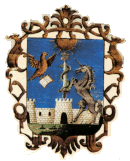
The main square of the town is Dobó Square. It was a market place in olden times. The Minorite Church and the Town Hall are the two chief attractions of the square. Also, there are two groups of statues there. István Dobó's statue, which was made of bronze by the sculptor Alajos Strobl in 1907, is on the east side i.e. in the direction of the Fortress, while "The Valiant Warriors of the Borders", which was made by Zsigmond Kisfaludy Strobl in 1967, is in front of the Town Hall.
(2 Eszterházy Square)
The Cathedral, which was built in honor of the evangelists Saint Michael and Saint John, is standing in the intersection of Széchenyi Street (also called Main Street) and Kossuth Lajos Street (previously called Káptalan Street) on the high ground of Pyrker Square. The Cathedral of Eger is the second biggest cathedral in Hungary. Eger was given archiepiscopacy in 1804, and János Pyrker, the bishop of Eger, ordered the designs of the building from the architect József Hild.
The Cistercian Church stands in the intersection of Széchenyi Street and Bródy Sándor Street. In olden times there was a Moslem mosque in the place of the church. The land was then given to the Jesuits, who started the construction of their monastery and church in 1699. The monastery was completed by 1727, and the masses were celebrated in the church from 1773 on but the building was finished a long time later only. The Jesuit order was dissolved in 1773 and the church was taken over by the Cistercians.
Serb families settled down in Eger in great numbers during the days of Turkish rule in Hungary (16th and 17th centuries). From the 17th century on they used a medieval Augustine church that stood in the place of the present church. They built their own church almost a hundred years later, in the late 18th century. They required the personal permission of Joseph II for building the church. The iconostasis of the church that was made after 1789 is a real masterpiece. It is an interesting fact that this is the only church that stands with its back to the town.
The episcopacy of Eger was founded by Steven I (the first Christian king of Hungary) in 1009. The church built during the first period in the history of the episcopacy has decayed almost without a trace. However, the ruins of the Norman style church that has three naves and was built in the 12th century can still be seen today. The current fortress was built after the Mongol invasion of Hungary in 1241-42 and was in its glory in the second half of the 15th century; the Gothic style episcopal see, where the Fortress Museum may be found, today was built at that time. Eger was the only town in 1552 to resist the invasion of the Turkish army which was superior in number. Inside the fortress visitors may see the Fortress History Exhibition, Hall of Heroes, Casamates, Gallery, and the Dungeon. Ispotály Cellar and the Éremverde (Mint) are brand new facilities.
(14 Kossuth Street.)
The Baroque style Franciscan church is on Kossuth Lajos Street, a street rich in historic buildings. The foundation stone was laid in 1736 by the architect Giovanni Battista Carlone. The facade and two towers of the building were constructed according to János Nitsman's plans. The gate and the statue of Mater Dolorosa were sculpted by Giovanni Adami. The church is famous for its altar which was made by the painter Pál Kronewetter and the sculptor Antal Steinhauser. The monastery was built between 1714 and 1749. Most of the cell doors and iron fittings are the original ones.
The County Hall was built between 1749 and 1756 based on the designs made by Mátyás Gerl. Its chief attractions are its two wrought-iron gates. They were made by Henrik Fazola, who came to Eger from Würzburg.
The College was being built from 1765 to 1785. When taking over the construction project Jakab Fellner made some minor changes to the original plans prepared by József Gerl. According to the plans the building would have been suitable for a four-faculty university, but neither Maria Theresa nor Joseph II gave their permission to such an institution. Thus the building was used for teaching theology and law, and also for training teachers. At present Eszterházy Károly Teachers' Training College is operating in the building, and the diocesan library may also be found there.
Szépasszony-völgy (Witch Valley) is the home of the world-famous wines of Eger. Those who have become tired of sightseeing may turn into one of the cellars hollowed into the rhyolite tuff hillsides. The walls of the cellars are covered with noble mould. The so called Öregsor (Old Row [of wine cellars]) was established in the 18th century, but the first cellars were probably made at an even earlier time.
The garden was owned by the archiepiscopacy of Eger. The garden used to be much bigger than it is now. It was built by Gábor Erdõdy between 1730 and 1735, and fenced in 1769. The portal on Klapka Street still exists. This two-leaf gate with a footpath crossing in the middle was constructed according to József Francz's design. The railing was made by Henrik Fazola. The layout of the garden is of French style, with some plane trees that are several hundred years old.
| Copyright © 1996 AgriaComputer Kft. |